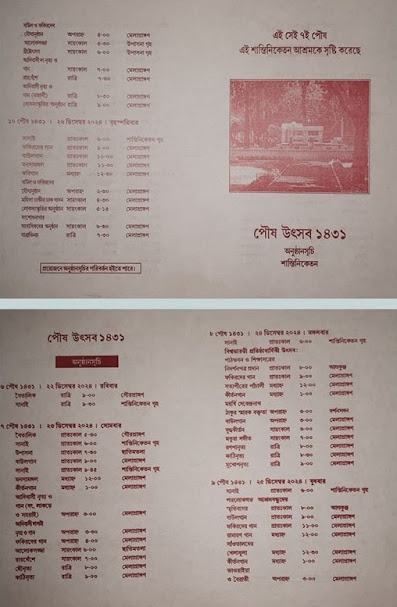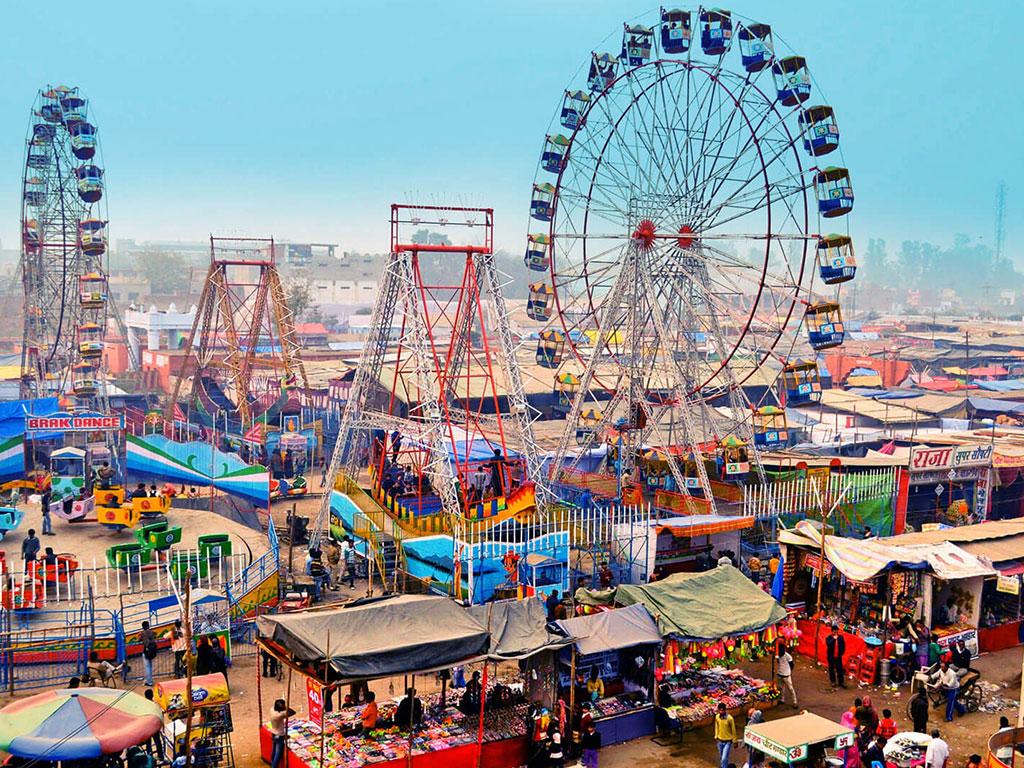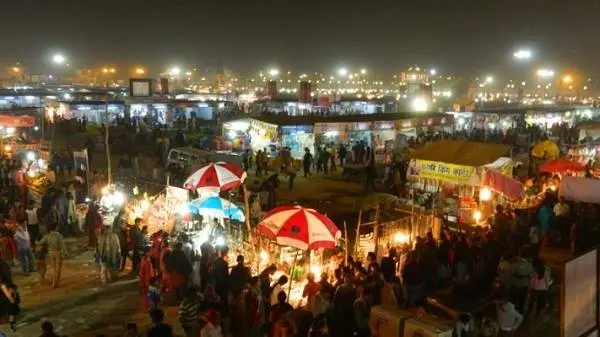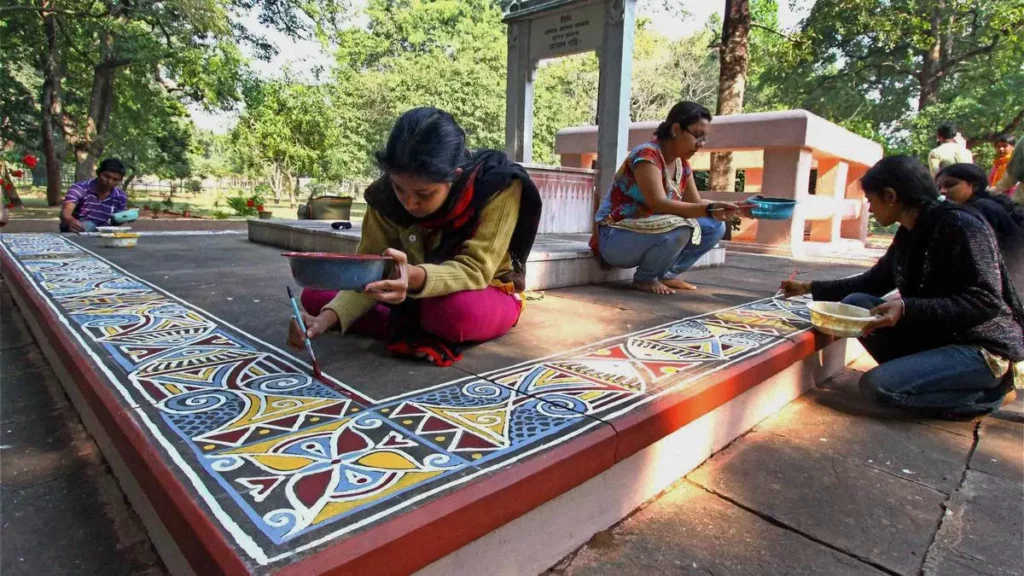After a long four-year period, Visva-Bharti and Santiniketan Trust will conduct the glorious Poush Mela 2024 (also spelled as Pous Mela; in Bengali this is ‘পৌষ মেলা’) at Santiniketan. The last mela was celebrated in the year 2019 by Visva-Bharti and Santiniketan Trust. After that, Bolpur-Santiniketan Poush Mela was conducted by the Government of West Bengal and local district authorities.
Poush Mela 2024 Schedule:
| Date | Monday, 23rd December 2024 (৭ই পৌষ ১৪৩১) to Saturday, 28th December 2024 till 12:00 noon (১২ই পৌষ ১৪৩১ দুপুর ১২টা পর্যন্ত) |
| Place | Mela Prangan, Purba Palli, Santiniketan, Birbhum |
| Nearest Airport | Netaji Subhas Chandra Bose International Airport, Kolkata. The airport is around 159 kilometers away from Santiniketan |
| Nearest Railway Station | Bolpur-Shantiniketan Railway Station. The Station is around 3 kilometers away from Mela Prangan, Purba Palli, Santiniketan. |
Pous Mela is a cultural celebration that embodies the spirit of Bengali tradition, culture, music, and art. Tourists from all over the world flock to Santiniketan every year to experience the much-anticipated poush mela. Prepare yourself for the spectacular Pous Mela, where you can truly embrace the vibrant heritage, art, and culture of Bengal.
Pous mela embodies Rabindranath Tagore’s vision and has significant historical and cultural roots. It has developed over time into a legendary occasion that draws thousands of tourists from all over the world.

Schedule of Poush Mela 2024 (১৪৩১)
History of Poush Mela
Origins of the Fair
The first Poush Mela was held on 7th Poush of 1298, according to the Bengali calendar. At the beginning of the fair, clothes and food items were donated to orphans. The idea of holding a fair has been directed in the Santiniketan Trust Deed. According to the deed, the trustees will try and take the initiative to hold a fair in Santiniketan to stimulate religious sentiments. In this fair, holy men of all communities can come and preach religion and have religious discussions. There should be no idolatrous worship on the premises of this fair, and there cannot be any ugly entertainment or revelry. All kinds of goods can be bought and sold in this fair except for alcohol and meat. (Tattavabodhini Patrika, Baisakh 1810).
Initially, the Mela served as a platform to spread the ideals of Brahmo Samaj, including simplicity, community bonding, and the rejection of idolatry. Over time, the fair expanded beyond its religious origins to become a cultural and social event celebrating rural Bengal’s art, crafts, and heritage.
Rabindranath Tagore’s Influence
Rabindranath Tagore played a crucial role in transforming Poush Mela into a celebration of Bengali culture. His vision of Santiniketan as a center of learning, art, and creativity influenced the fair’s evolution. Tagore envisioned the Mela as an opportunity for local artisans, musicians, and performers to showcase their skills and for visitors to experience the richness of rural traditions.
Under Tagore’s guidance, the Mela embraced folk music, especially baul songs, tribal dances, and crafts, turning it into a vibrant representation of Bengal’s rural life. The Nobel laureate’s philosophy of harmony between nature and humanity resonated with the fair’s ambiance, making it a reflection of his ideals.
The Legacy of Poush Mela
Cultural Significance
Poush Mela is not just a fair; it is a celebration of Bengal’s diverse cultural heritage. The event highlights:
- Folk Music and Dance: The Bauls of Bengal, with their soulful melodies and philosophical lyrics, are the heart of Poush Mela. Performances by other folk artists, including tribal and rural dancers, add to the fair’s charm.
- Art and Handicrafts: Local artisans showcase their handmade crafts, weaving traditions, and pottery. These stalls provide a glimpse into Bengal’s artisanal legacy.
- Literature and Intellectual Exchange: As a part of Tagore’s Santiniketan, the Mela often becomes a platform for literary discussions and intellectual debates, attracting thinkers, writers, and poets.
Economic Impact
For local artisans, weavers, and traders, Poush Mela is a significant economic opportunity. It enables them to connect directly with customers, bypassing intermediaries. The fair serves as a vital platform for sustaining traditional crafts like kantha stitching, dokra art, and terracotta sculptures.
Spiritual Essence
The Mela still retains its spiritual essence, beginning with the Baitalik procession, where students and residents of Santiniketan sing devotional songs at sunrise. The simplicity and serenity of this tradition underscore the philosophical roots of the event.

Evolution and Trends in Poush Mela
Changing Format Over the Years
- From Simplicity to Grandiosity
Initially, Poush Mela was a modest gathering with a handful of participants. Over time, the fair grew in scale and popularity, with thousands of visitors attending from different parts of the world. The cultural performances and exhibitions expanded to include more diverse art forms. - Global Appeal:
The Mela’s fame crossed national boundaries, attracting international tourists and scholars. The global audience brought a new dynamic, leading to the inclusion of multicultural elements while retaining its Bengali essence.
Modern Challenges
Despite its enduring charm, Poush Mela has faced several challenges:
- Environmental Concerns:
The influx of large crowds and commercialization has raised environmental issues. Noise pollution, littering, and the strain on local resources have sparked debates about sustainable practices for the Mela. - Legal and Administrative Issues:
In recent years, disputes over permissions, security, and management have occasionally disrupted the fair. The introduction of stricter regulations has led to changes in its scale and organization.
Technological Integration
The integration of technology into Poush Mela is one of its recent trends. Live streaming of performances, online promotion, and digital ticketing have made the event accessible to a broader audience. Social media platforms play a pivotal role in attracting younger visitors and spreading awareness about the fair.
Highlights of Poush Mela
Art and Craft Stalls
Artisans from Santiniketan and surrounding areas set up stalls offering handmade crafts, paintings, and textiles. The fair is an ideal place to purchase Santiniketan leather goods, Batick prints, and kantha-stitched garments, making it a shopper’s paradise.
Baul Performances
The soulful melodies of the Bauls, wandering minstrels of Bengal, are the essence of Poush Mela. Their songs, rich with spiritual and philosophical themes, captivate audiences, creating a unique connection between the performer and the listener.

Food and Delicacies
Poush Mela is also a culinary delight, with stalls offering traditional Bengali dishes like pithe-puli, kachoris, and jilipi (jalebi). The aroma of hot tea served in earthen cups adds to the fair’s rustic charm.
Cultural Programs
Dance dramas, recitals of Rabindra Sangeet, and theatrical performances are integral to Poush Mela. These events reflect the artistic spirit of Santiniketan and provide a platform for students and artists to showcase their talents.
Poush Mela in Contemporary Times
Sustainability Efforts
In response to environmental concerns, recent editions of Poush Mela have incorporated eco-friendly measures:
- Reduction of plastic waste
- Emphasis on biodegradable materials
- Awareness campaigns on cleanliness and sustainability
Impact of the Pandemic
The COVID-19 pandemic significantly impacted Poush Mela, leading to cancellations or scaled-down versions of the event in 2020 and 2021. Virtual celebrations and online exhibitions were organized to keep the tradition alive, showcasing the adaptability of the fair in challenging times.
Balancing Tradition and Modernity
While embracing modern elements, Poush Mela continues to prioritize its cultural and spiritual roots. Efforts are being made to strike a balance between tradition and contemporary trends, ensuring that the fair remains relevant to future generations.
Future of Poush Mela
As Poush Mela evolves, its future lies in maintaining its cultural integrity while addressing modern challenges. Key areas of focus include:
- Sustainable Growth:
Adopting eco-friendly practices and managing resources efficiently to preserve the fair’s natural and cultural environment. - Promotion of Local Artists:
Providing more opportunities and support to rural artists, ensuring their crafts gain global recognition. - Enhanced Accessibility:
Leveraging technology to make Poush Mela more accessible to people worldwide while improving infrastructure for visitors.
Conclusion
Poush Mela is more than a fair; it is a celebration of life, culture, and heritage. Rooted in the ideals of the Tagore family, the event has evolved into a symbol of Bengal’s artistic and spiritual essence. Its legacy, enriched by the contributions of countless artists and performers, continues to inspire generations.
As the fair navigates the complexities of modernity, its enduring charm reminds us of the beauty of tradition and the importance of preserving our cultural roots. Poush Mela remains a shining beacon of Bengal’s rich heritage, captivating hearts and minds with its timeless appeal.
Poush Mela, held in Santiniketan, West Bengal, is a cultural celebration that embodies the spirit of Bengali tradition, music, and art. This fair, deeply rooted in history and cultural significance, reflects the vision of Rabindranath Tagore and his family. Over the years, it has evolved into an iconic event that attracts thousands of visitors from across the world. In this blog, we delve into the origins, cultural significance, legacy, and contemporary trends of the Poush Mela, a unique blend of tradition and modernity.


